While swimming pools and a day at the beach are great fun, there are some hazards to watch for that can have long term consequences.
50% of those hospitalized due to a non-fatal drowning require further care with many experiencing long-term disabilities.
In this article, we’ll discuss many of these dangers and supply preventative measures that will keep you and your loved ones safe.
Home Pool Safety
Approximately ten people die every day in the U.S from non-boating-related drowning incidents.
Of these, roughly one in five are children under the age of 14. In most situations, these accidents are preventable.
If you own a pool or spend a lot of time near the water, teach your children to swim at a young age, either by teaching them yourself or enrolling them in a course. Even basic skills like floating or treading water can be life-saving.
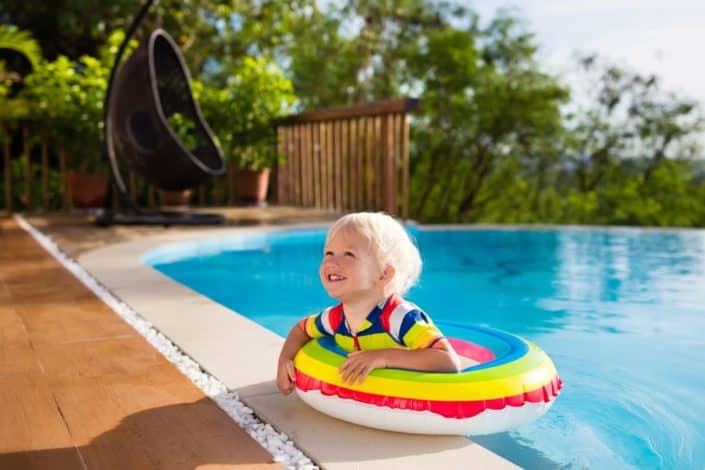
Until you trust your kids to swim competently, have them wear a fitted life jacket. To make sure the life jacket is secured, lift your child’s jacket by the shoulders and make sure the chin and ears don’t slip through.
AVOID or THROW AWAY floatation accessories such as buoys and water wings. These are involved in many fatal and non-fatal drownings.
Even after your children become good swimmers, never leave them unattended.
At a minimum, the adult responsible for watching over the children should be certified in First Aid and CPR.
Keep your pool up to date with all necessary maintenance. Drains and suction tubes are the most important areas to monitor. If your child is missing, always check the pool first.
Sun Precautions

Sunburn or similar afflictions can occur fast when on or near the water. This is due to the sun reflecting off the water’s surface and magnifying the impact.
Always apply sunscreen before going in the water and make sure that you give it time to absorb.
Monitor your skin and those around you. The most vulnerable spots can be areas we can’t see ourselves.
The glare will often prevent you from properly seeing when you’re getting burned. Take frequent breaks in the shade to check your skin’s condition.
That glare can be hazardous for your eyes too. Wear sunglasses or a brimmed hat to keep the worst of it off your face.
Swimming Safety At a Lake or Ocean
Rip Currents
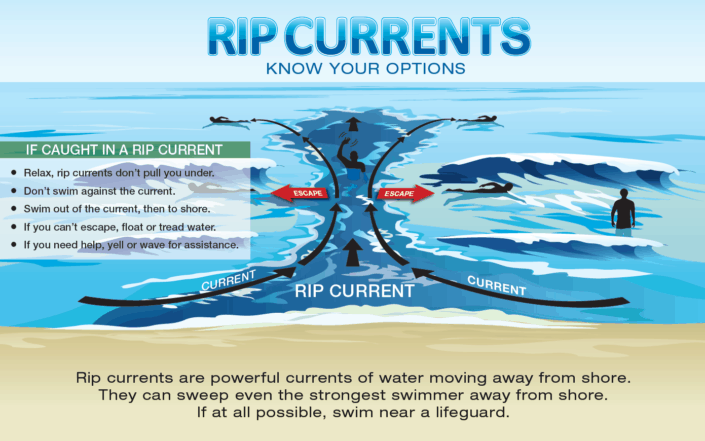
Capable of speeds of eight feet per second, rip currents (also known as rip tides) can move faster than an Olympic swimmer.
These currents form from waves piling up along the shoreline. In order to return to the ocean, they will sometimes form narrow currents rushing back to deep water.
They can occur in most oceans and the great lakes of North America.
Most beaches with the threat of rip currents have signs posted along the beach. Look for these or ask locals before entering the water.
If going beyond a few feet of water you should be a strong swimmer and have someone with you.
If you get stuck in a rip current, do NOT try to swim back to shore. The strength of the current will keep you from making any progress and push you further from the beach.
Instead swim parallel to the shore. Continue swimming until out of the current, conserving energy as best as possible. Once clear of the rip, swim toward the beach.
If unable to escape, concentrate your energy on floating and treading water. Call, wave, or use any other method at your disposal to get the attention of someone onshore.
Where to Swim
In addition to rip currents, there may be other dangers that make some beaches unsafe to swim in.
Whether it’s dangerous marine life like sharks and jellyfish, coral reefs, rip currents, or other factors, only swim within safe and supervised areas.
If a section of the beach has been closed to swimming, there’s probably a good reason.
Immersion Hypothermia
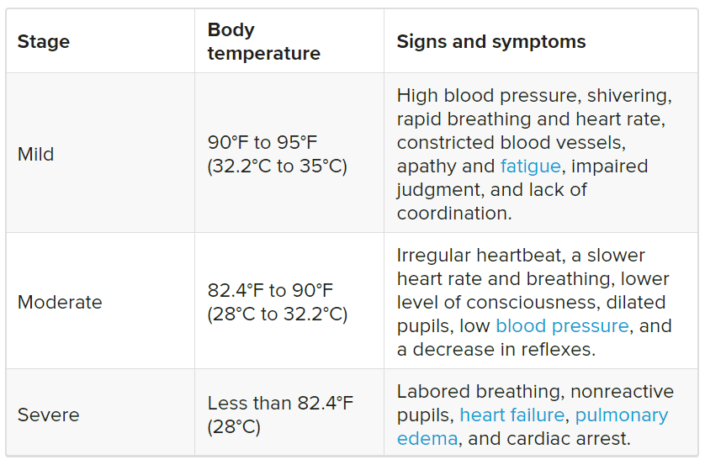
A specific form of hypothermia brought about by being in cold water. Since water conducts heat away from the body 25 times quicker than air does, symptoms such as numb appendages, shock, disorientation, and unconsciousness can appear and accelerate rapidly.
You can protect yourself from immersion hypothermia by wearing a wetsuit or drysuit conducive to the water temperature you’ll be swimming in. While it won’t protect you indefinitely, it will buy you time.
Whether the person is wearing a wetsuit or not, it’s important to get them out of the water as quickly as possible.
Help the person in the water stay calm. Panicking and thrashing will only accelerate body heat loss.
Know Your Skills
At a minimum, those that spend time on the water should be certified in First Aid and CPR.
The further you are from help, the wider your knowledge base should be. The best way to handle an accident is to avoid it before it happens. Learn how to read the water, predict the weather, and communicate it to others.
How to Help Others
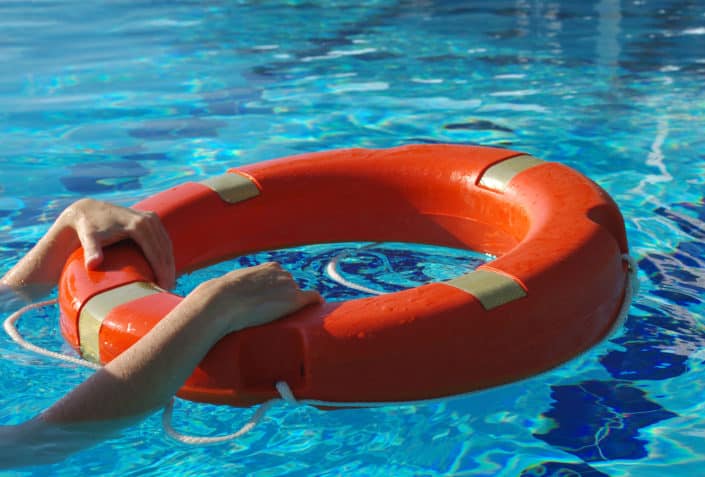
The most common scenario is a person struggling to swim or drowning. While your first impulse may be to dive into the water, this can cause more harm than good.
If the reason they’re struggling is because of any hazards, you’ll likely be in danger too. Instead the American Red Cross implores us to, “reach or throw, don’t go.”
Provide aid by throwing a life ring or anything else that floats. If they’re close enough, try to grab their hand.
Those with Wilderness First Responders (WFR) must be given consent before they can legally treat an injured person in the backcountry. Should you come across an unresponsive patient however, consent is implied and you can provide assistance if necessary.
But unless you’re a licensed paramedic or have qualified medical expertise, you should call 911 or other emergency personnel as soon as possible.
Swimming Safety for Kids & Parents
Design a barrier around your pool to keep children out when they can’t be properly supervised.
When the pool is open, children should be carefully watched at all times.
Assign a Water Watcher that wears a tag around their neck or wrist. They should NEVER leave children out of sight, even when out of the water.
If the Water Watcher needs to leave, they should pass the tag to someone else before doing so.
Any Water Watcher should be certified in First Aid and CPR.
Even at a public pool with an on-duty lifeguard, you should never leave young children unattended.
If you own a pool, check any drains or suction outlets before each use. Swimsuits or appendages can get stuck in an improperly covered drain with disastrous results.
Swimming Safety for Teens
It may be harder to convince teenagers to be responsible at the pool or lake, but do your best to impress on them the importance of swimming safely.
Insist that they always swim with a friend and to look out for others if they’re in a group by keeping a headcount.
Encourage them to take a swim or safety class if they’re frequent swimmers. This will not only teach them life-saving skills, but stresses responsibility and shines a spotlight on potential dangers.
Make sure they know the water depth before attempting a dive and that they tell you whenever they’re going swimming.
Ask them where they’re going, who they’re going with, and how much actual swimming they plan on doing.
Have a grasp of how good of a swimmer they are and see if their skill and endurance level matches what they want to attempt.
If on a boat, make sure they have the proper life jacket. Youth-sized PFDs are based on weight while adult PFDs are based on size.
Make sure you update your PFD collection accordingly as your teen grows. In most cases, youth-sized life jackets are good up to about 100 pounds.
Swimming Safety for Adults
All the lessons that apply to teens also apply to adults. Never swim on your own, never swim under the influence, etc.
Be aware of water conditions and your own personal skill level.
Distances over water can be deceptive. If you’re setting out and are unsure how long it will take, it’s better to choose a more conservative route.
Boating Safety
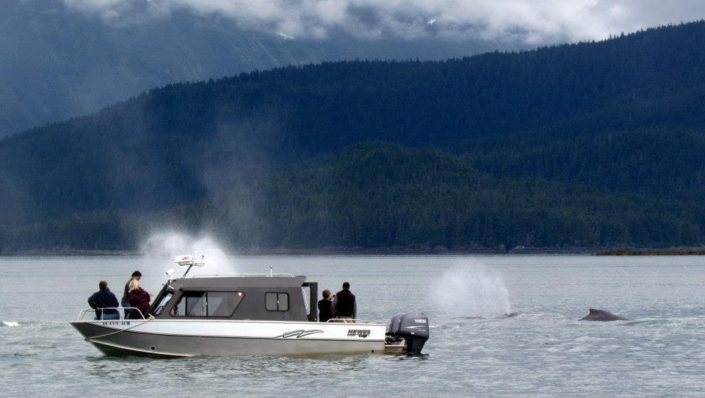
No matter the conditions or location, there should always be a life jacket on board for each person.
Other emergency equipment that should be present are emergency flares, a radio, horn or whistle, and a fire extinguisher.
Ensure that the boat operator is familiar with basic boat engine maintenance and is acquainted with the water’s “rules of the road.”
Just like you’d never get in a car with someone under the influence, never board a vessel with an impaired captain.
Before departing, file a float plan including where you’re going, when you’ll return, and a visual description of your vessel.
And if you’re going with children, be sure to read this article on how to keep children safe while boating.
Cold Water Safety
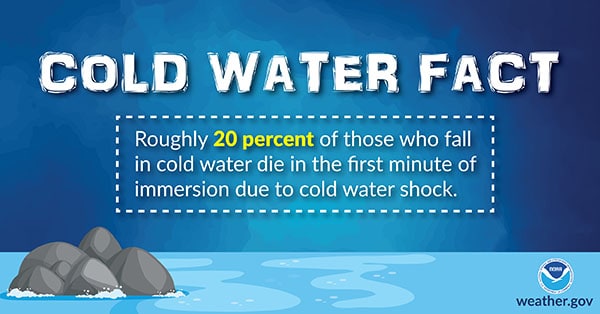
Wearing a life jacket is even more important in cold water. Should you fall in, the cold shock of the immersion can cause your muscles to seize.
The natural instinct is to gasp and take a deep breath, filling your lungs with water and pulling you down. A properly worn PFD will keep you near the surface while your body overcomes the shock.
If rescue is not imminent, don’t try to swim. It won’t keep you warm and will expose more of your body making you lose heat faster.
Wrap yourself into a tight ball that will minimize the exposed surface area. If in a group, huddle together. Climb on top of any floating debris to get as much of your body as possible out of the water.
Depending on the temperature of the water and the individual, it is possible to survive for hours in cold water if you take the proper steps and minimize panic.
Be Responsible
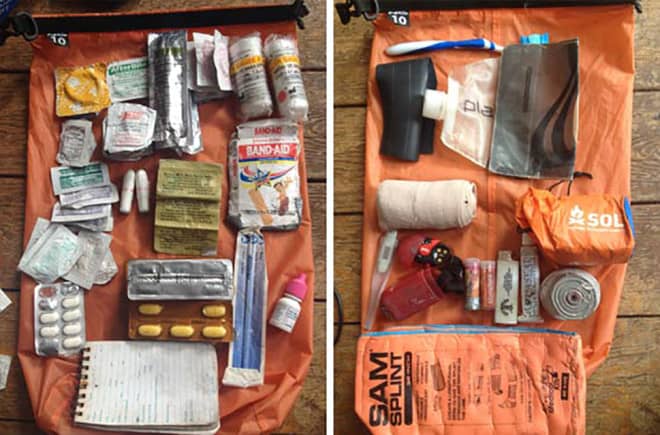
The most responsible action you can take if you’re going to a sparsely populated area is to tell someone where you’re going and when to expect you back.
Let your contact know who they should get in touch with if they don’t hear from you by a specific time.
Bring along the proper floatation equipment. If traveling in a group, ensure everyone has a PFD.
Sunscreen should be in your bag regardless of the weather forecast. Make sure there’s at least one first aid bag with basic supplies (band-aids, Neosporin, ace bandage, etc). A designated “hypo bag” is a good idea with spare clothes.
Bring plenty of water and food, enough to last you a day longer than you anticipate being out in case weather or other circumstances arise.
What to do in an Emergency
First and foremost, stay calm! If an injury is part of the emergency, apply medical attention to the best of your ability.
When in doubt, don’t attempt to move the injured party. Doing so may cause more harm than good.
Notify the proper emergency personal, either the Coast Guard, Park Service, or whoever else may be able to provide assistance. Wave down a passing vessel or hail one on the radio. On a marine VHF radio, channel 16 is reserved for hailing and emergency and is monitored by the Coast Guard.
If you can do so safely, get to shore. But once there, stay put. It may be tempting to set out in search of help, but rescue crews will begin their search at your last known location.
If you stuck to your float plan, they should find you. Make yourself as conspicuous as possible by lighting a fire, waving reflective clothing, or trying to flag down passing vessels.
Water Safety – Conclusion
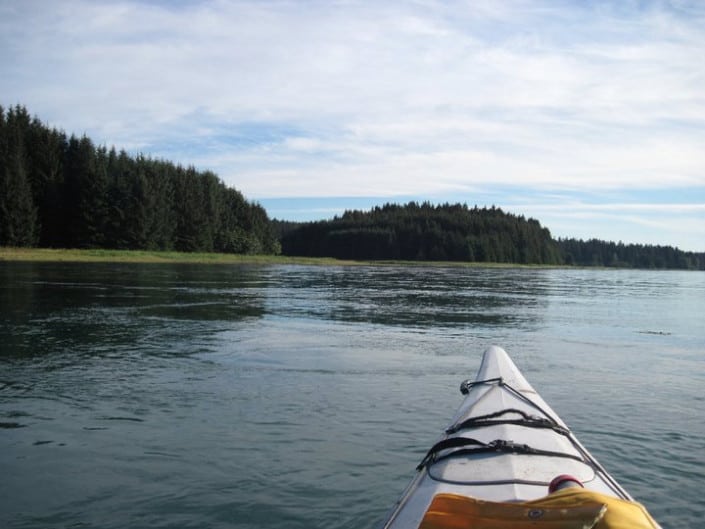
I hope that reading this article has supplied you with the knowledge you need to keep you, your friends, and family safe on and in the water.
Simple precautions like wearing a life jacket or taking a CPR course can make all the difference. Hopefully, you’ll never have to use it, but if you do, you’ll be glad you know how.
Did we miss anything important? Do you have your own stories or suggestions to share? Let us know in the comments below.



